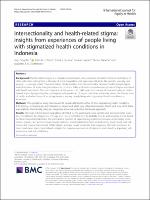| dc.description.abstract | Background:
Disruptions in essential health services during the COVID-19 pandemic have been reported in several countries. Yet, patterns in health service disruption according to country responses remain unclear. In this paper, we investigate associations between the stringency of COVID-19 containment policies and disruptions in 31 health services in 10 low- middle- and high-income countries in 2020.
Methods:
Using routine health information systems and administrative data from 10 countries (Chile, Ethiopia, Ghana, Haiti, Lao People’s Democratic Republic, Mexico, Nepal, South Africa, South Korea, and Thailand) we estimated health service disruptions for the period of April to December 2020 by dividing monthly service provision at national levels by the average service provision in the 15 months pre-COVID (January 2019-March 2020). We used the Oxford COVID-19 Government Response Tracker (OxCGRT) index and multi-level linear regression analyses to assess associations between the stringency of restrictions and health service disruptions over nine months. We extended the analysis by examining associations between 11 individual containment or closure policies and health service disruptions. Models were adjusted for COVID caseload, health service category and country GDP and included robust standard errors.
Findings:
Chronic disease care was among the most affected services. Regression analyses revealed that a 10% increase in the mean stringency index was associated with a 3.3 percentage-point (95% CI -3.9, -2.7) reduction in relative service volumes. Among individual policies, curfews, and the presence of a state of emergency, had the largest coefficients and were associated with 14.1 (95% CI -19.6, 8.7) and 10.7 (95% CI -12.7, -8.7) percentage-point lower relative service volumes, respectively. In contrast, number of COVID-19 cases in 2020 was not associated with health service disruptions in any model.
Conclusions:
Although containment policies were crucial in reducing COVID-19 mortality in many contexts, it is important to consider the indirect effects of these restrictions. Strategies to improve the resilience of health systems should be designed to ensure that populations can continue accessing essential health care despite the presence of containment policies during future infectious disease outbreaks. | en_US |




